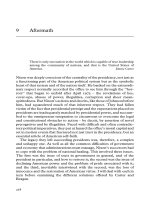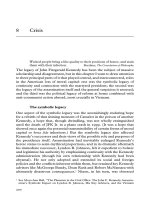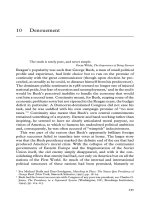Corporations: Paid-in Capital and the Balance Sheet pot
Bạn đang xem bản rút gọn của tài liệu. Xem và tải ngay bản đầy đủ của tài liệu tại đây (259.33 KB, 48 trang )
Corporations: Paid-in
Capital and the Balance
Sheet
Chapter
13
Objective 1
Identify the Characteristics
of a Corporation.
Characteristics
–
separate legal entity
–
continuous life and transferability of ownership
–
no mutual agency
–
limited liability of stockholders
–
separation of ownership and management
–
corporate taxation
–
government regulation
Organizing a Corporation
•
The process of creating a corporation
begins when the organizers
(incorporators) obtain a charter from the
state.
•
The charter authorizes the corporation to
issue stock and conduct business in
accordance with state law and the
corporation’s bylaws.
Organizing a Corporation
•
Stockholders elect the board of directors.
•
The board sets policy, appoints the officers,
and elects a chairperson.
•
The board also designates the president,
who is the chief operating officer.
Authority Structure
in a Corporation
Stockholders
Board of Directors
Chairperson of the Board
President
Various Vice-Presidents and Secretary
Controller Treasurer
Capital Stock
•
Corporate ownership is evidenced by a
stock certificate which may be for any
number of shares.
•
The total number of shares authorized is
limited by charter.
Stockholders’ Equity
Paid-in capital
Paid-in capital
Retained earnings
Retained earnings
Owners’ equity in the corporation
has two components:
Stockholders’ Equity Example
On June 1, the Bloom’s Corporation
issued stock valued at $10,000.
June 1
Cash 10,000
Common Stock 10,000
Issued stock
Stockholders’ Equity Example
Bloom’s Corporation net income
for the year was $800,000.
December 31
Income Summary 800,000
Retained Earnings 800,000
To close net income to Retained Earnings
Stockholders’ Rights
•
The ownership of stock entitles stockholders
to four basic rights, unless specific rights are
withheld by agreement.
1
Vote
2
Dividends
3
Liquidation
4
Preemption
Classes of Stock
•
Common stock is the most basic form of
capital stock.
•
Preferred stock gives its owners certain
advantages over common stockholders.
Classes of Stock
•
What is par value?
•
It is an arbitrary amount assigned to a share
of stock.
•
Most companies set the par value of their
common stock quite low to avoid legal
difficulties from issuing their stock below
par.
Classes of Stock
•
No-par stock does not have a par value.
•
Some have a stated value.
•
Stated value is an arbitrary value assigned
to a share of common stock.
•
This is similar to par value.
Objective 2
Record the Issuance of Stock.
Issuing Stock Example
•
On January 13, Martin Corporation, which
manufactures skateboards, issues 10,000
shares of common stock for $10 per share.
Issuing Stock Example
The shares were issued at par of $1.
January 13
Cash (10,000 shares @ $1) 10,000
Common Stock 10,000
Issue common stock at par
Issuing Stock Example
The shares were issued at a premium
of $9 per share.
January 13
Cash (10,000 shares @ $10) 100,000
Common Stock 10,000
Paid-in Capital in
Excess of Par-common 90,000
Issue common stock at a premium
Issuing Stock Example
The $1 stated value shares were
issued at a premium of $9 per share.
January 13
Cash (10,000 shares @ $10) 100,000
Common Stock 10,000
Paid-in Capital in
Excess of Stated Value 90,000
Issue common stock at a premium
Issuing Stock Example
Assume the shares were no-par common stock.
January 13
Cash (10,000 shares @ $10) 100,000
Common Stock 100,000
Issue no-par common stock
Issuing Stock Example
•
On September 11, Martin Corporation issued
15,000 shares of its $1 par common stock for
a building worth $100,000.
•
What is the journal entry?
Issuing Stock Example
September 11
Building 100,000
Common Stock (15,000 @ $1) 15,000
Paid-in Capital in Excess
of Par-common ($100,000 – $15,000) 85,000
Issued common stock in exchange for a building
Issuing Preferred Stock
•
Accounting for preferred stock follows the
pattern illustrated for common stock.
•
Stockholders’ equity on the balance sheet
lists preferred stock, common stock, and
retained earnings – in that order.
Objective 3
Prepare the Stockholders’
Equity Section of a
Corporation Balance Sheet.
Paid-in Capital:
Preferred stock, 5%, $100 par,
5,000 authorized, 400 shares issued $40,000
Paid-in capital in excess of par–preferred 14,000
Total paid-in capital, preferred stockholders $54,000
Review of Accounting
for Paid-In Capital
Stockholders’ Equity









